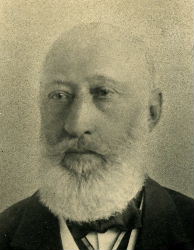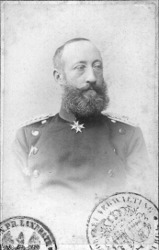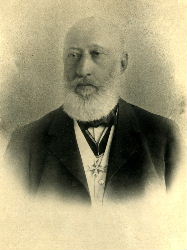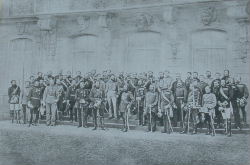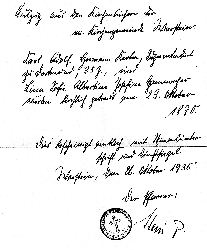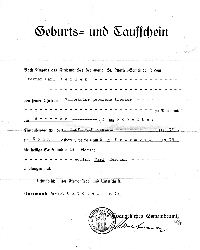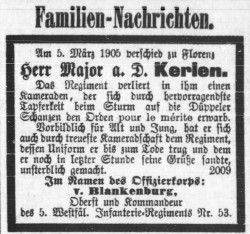|
Biography Karl Kerlen
Carl Kerlen went to the city grammar school in Dortmund and according to his parents wish should become a theologist.
Instead, the only son went to America looking for adventure. From 1854 to 1857 he struggled as tree feller and lumberman
and thus became familiar with the several tree species he later would plant in his park in Arnsberg. He was lucky to
save the life of the daughter of an Indian chief. The Indian rewarded him with his knowledge about a gold-rich region
and Karl found so much of it that he could finance his retrn to Germany and living for a while in the old
homeland.
After his return he soon decided to become a soldier. At first he enlisted for a year in the artillery guard.
From 1859 on he was apprentice at a farm near Kamen. After the mobilization he became
Landwehr officer. 1860 he was transferred to the
53rd Regiment of Infantery and was stationed in Münster and in Warendorf. After
that he was commanded to the training battalion to Potsdam. 1864 he participated in the
Second Schleswig War which would be of crucial
significance to him.
|
Besides the danevirke, which formed the southern defense line
of the Danes since historical times, the Dybbøl Fort
on the Als Strait represented the bastion of defense for
protecting the crossing to the Danish islands and had withstood all previous sieges and escalade attempts. After
the Danes had vacated Schleswig and Flensburg and abandoned the danevirke in February 1864 they retreated to
Dybbøl Fort and made sure all 10 sconces
were clear for shooting. For us, the last and finally decisive escalade of the sconces is important. It took place
ont April 18th 1864 and started in the morning at 4 am.
The sconces were shelled for six hours by heavy siege artillery.
|
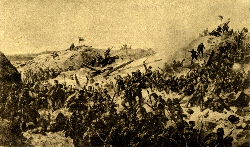
Escalade of Dybbøl Fort
on April 18th 1864
|
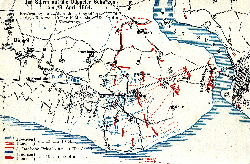 The assault proper at the sconces begann at 10 am. Theodor Fontane reports in his book "The Schleswig-Holstein
War in the Year 1864" on pages 207 to 222 thoroughly about the assualt on sconce&IV in the middle field, which
is reported to have been the strongest part of the complex. In order to assault sconce IV at exactly 10 am
the companies of the 53rd Regiment drifted from the parallel postion towards
the sconce. The way to this complex lead through fortifications III and V while scone III was conquered
no less than five times during the turmoil of battle. Colonel v. Buddenbrock, the commander of the
53rd Regiment, who recognized this, intervened energetically stopping the
stream of the fighting men and forced them to move to the actual goal, the assault on scone IV. The Danes,
realizing the intentions of the enemy, climbed to the crown of the scone and opened a strong musket fire. In spite
of this obstacle the crew advanced under heavy losses and finally climbed up the breastwork. Literally we read
in Fontane's book on page 209:
The assault proper at the sconces begann at 10 am. Theodor Fontane reports in his book "The Schleswig-Holstein
War in the Year 1864" on pages 207 to 222 thoroughly about the assualt on sconce&IV in the middle field, which
is reported to have been the strongest part of the complex. In order to assault sconce IV at exactly 10 am
the companies of the 53rd Regiment drifted from the parallel postion towards
the sconce. The way to this complex lead through fortifications III and V while scone III was conquered
no less than five times during the turmoil of battle. Colonel v. Buddenbrock, the commander of the
53rd Regiment, who recognized this, intervened energetically stopping the
stream of the fighting men and forced them to move to the actual goal, the assault on scone IV. The Danes,
realizing the intentions of the enemy, climbed to the crown of the scone and opened a strong musket fire. In spite
of this obstacle the crew advanced under heavy losses and finally climbed up the breastwork. Literally we read
in Fontane's book on page 209:
"Among the front most were the First Lieutenants v. Baer, Benkendorff and v. BAstineller and the Second
Lietenants Kerlen and Coppenrath."
And on page 222 one can find the footmote:
"During the assault on scone VIII also participated Lieutenant Kerlen from the
53rd Regiment who, dodging the front on the rear side, climbed up the
breastwork from the North. This was the third scone Lieutenant Kerlen helped to seize. He outstanden on all
three of them. He belonged to the 4th Assault Company and was
- besides Lieutenant Loebbecke - amonng the first in scone IV. From scone IV he attacked
with 30 to 40 men from the most different regiments scone VII and ewas here perhaps the first."
Perhaps on this scone the story took place on which the Dortmunder Newspaper from
January 11th 1927 reported at the end of an article on the Hammacher
Family. According to it Karl Kerlen unsheathed his sword and threw it over the palisade while shouting to his people:
"March ahead, we will fetch it back!" And as this bravery act worked out Karl Kerlen earned the order
"Pour le Mérite" for exceptional courage. On the
Kerlen Farmyard in Schleswig Holstein his descendants still keep a picture with a dedication from Crown Prince
Frederick William, the later King Frederick
William III and, as we surpringly learned during our visit this year, also the order.
A consequennce of this distinction was also that Carl was allowed to accompany as a an orderly official the then
Crown Prince Frederick William to the homage ceremony to Münster in Westphalia which took place before the
Prussian Royal Couple on October 18th 1865, the
50th anniversary of the reunion of Westphalia with Prussia; an additional
distinction for a Kerlen as the grandfather was one of the first Prussian functionaries during difficult times
in Münster.
Now as company leader he participated in the war against Austria in 1866 and was moved to the
86th Infantery Regiment in Zeitz. After completion of this military campaign
he was forwarded to captain. 1870 he was instructor, later supplementary commander at the non-commissioned officer
school in Weissenfels. In this year also the wedding with the daughter of the iron works owner
Wilhelm Hammacher in Warstein took place, about which there also is an anecdote to tell.
In order to conceal the very private matter during war times and even before his men he telegraphed to Warstein:
"Keep mare Lina ready for Captain Kerlen." Lina Hammacher and Carl Kerlen
knew each other already from childhood as the pastor family lived opposite the Hammacher store in Dortmund. Father
Wilhelm Hammacher had taken over management of the iron works in Warstein only later and left the management
of the business in Dortmund to his still fit father. The wedding finally took place on
October 23rd 1870 in Warstein.
A short time after his marriage Carl went to the Occupation Army in Paris and repelled an attack by the French at
Mont Valerien. And now we read in the family chronicle of the Kerlens the decisive sentence: On the day before
he had attended the king's proclamation in the Mirror Gallery of the Palace of Versailles. So in fact he was
present at this celebration and of course could be depicted among the numerous military persons on both paintings
that were released later.
In March Captain Kerlen moved wih his wife to Weissenfels. The young family lived there during the following years,
where also the first two sons were born. Both grandparent couples, senior reverend and superintendent Kerlen from
Dortmund and his wife as well as the Hammacher family, iron works owners in Warstein, are mentioned as proud godparents.
Unfortunately, the first son Karl only lived for 14 days. On 30.8.1873
the second son was born to the couple and named Curt Karl Albrecht. The first
chronicles, from which in particular we have taken the illustrating stories, stem from descendants of this son.
Lina was with her 20 years commander's wife and so we would like to believe the story which is supposed to
have taken place one Sunday, as the personnel was attending church services. A lieutenant, who had been transferred to
Weissenfels for disciplinary reasons, announced himself at the commander's family just at the time of church going to
report. Grandson Fritz Kerlen relates the story as follows:
Grandmother went to the door herself and opened it for the guest, clad with a lace bonnet, as was the use of the time.
The entering lieutenant grabbed the young woman under the chin and said: "Well, petite, is the old captaineuse
(captain's wife) there?" Grandmother Lina dropped a courteous curtsy, led the young man to the living room
and asked him to wait there for the masters. Meanwhile she changed clothes and presented herself to the puzzled
lieutenant as the "squaw".
1875 we find the capain at the 79th Regiment in Hamelin, were daughter
Karla was born on August 7th.
1878 he was relocated to Brandenburg and forwarded to Major and Battalion Commander at the
35th Regiment of Infantery. He took a longer vacation because of
health problems. Gout and rheumatism afflicted him so much that he first went away on leave and finally left
completely and moved to Arnsberg.
The Arnsberg Forest was above all the main motivation for Arnsbeg as a senior's retreat. The Major's father-in-law,
Wilhelm Hammacher, had purchased forest areas near the Lake of Möhn and Hevebecken for the exploitation of wood
charcoal and Carl hoped to administrate them and above all to be able to pursue his passion for hunting. The family
first had its residence at King Street opposite Prälatur Street. Unfortunately everything turned out to be
a little bit different as 1881 the iron works owner Hammacher died and the businessman
Arnold Luyken, who had been appointed with the repartition of the inheritance,
and by the way was a son of the district judge of Arnsberg and at the same time
Hammacher's son-in-law, decided according to economical considerations that the forest should be sold. With Lina's
part of the sale of the iron works in Warstein, the Major determinedly proceeded to buy the parcels from the
peasants at the prolongation of King Street short of Eichholz Woods, so that soon they asked each other:
"Did the crazy Major also buy a little land field from you?"
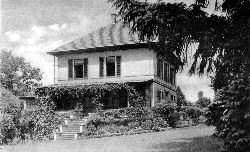 Kerlens built an Italian style mansion with many
windows on the estate and moved in on March 15th 1883. As the big
window panes are said to have been aimed at by a scallywag, at first there was some trouble. Two things are
supposed to have contributed to a change in the relationship with the neighbours: For one the Major made it clear that
as a passionate hunter and a military he possessed a rifle and could shoot fairly well and also he presented leading
persons of the catholic community of Arnsberg with rosaries with special dedications and blessing wishes
brought from a travelling trip, with which the protestant Kerlen made it clear that he intended to respect the
beliefs of the majority of the
population. Around the mansion, according to Kurt Kerlen, he laid out a park of about 5 hectares on which he
planted numerous trees from North America. Besides the lovely trees, shrubs and flowers there was a small lake and
a bowling lane. Prince Pückler may have been the inspiration for the layout, a guest once said; perhaps it was the
Wörlitzer Park, which Kerlens could have
known from their stay at Weissenfels or Zeitz. Allegedly, from each tree species two specimens were first
ordered and planted but afterwards only one tree, especially from the fast-growing types, was allowed to grow
in the park. A mighty American Oak today still dominates the lower part of the garden, which was passed over to
daughter Karla and so later to the Schmale Family.
Kerlens built an Italian style mansion with many
windows on the estate and moved in on March 15th 1883. As the big
window panes are said to have been aimed at by a scallywag, at first there was some trouble. Two things are
supposed to have contributed to a change in the relationship with the neighbours: For one the Major made it clear that
as a passionate hunter and a military he possessed a rifle and could shoot fairly well and also he presented leading
persons of the catholic community of Arnsberg with rosaries with special dedications and blessing wishes
brought from a travelling trip, with which the protestant Kerlen made it clear that he intended to respect the
beliefs of the majority of the
population. Around the mansion, according to Kurt Kerlen, he laid out a park of about 5 hectares on which he
planted numerous trees from North America. Besides the lovely trees, shrubs and flowers there was a small lake and
a bowling lane. Prince Pückler may have been the inspiration for the layout, a guest once said; perhaps it was the
Wörlitzer Park, which Kerlens could have
known from their stay at Weissenfels or Zeitz. Allegedly, from each tree species two specimens were first
ordered and planted but afterwards only one tree, especially from the fast-growing types, was allowed to grow
in the park. A mighty American Oak today still dominates the lower part of the garden, which was passed over to
daughter Karla and so later to the Schmale Family.
The Major was co-founder of the Casino Society and interfered in all kinds of matters not only in his capacity as
city council, if he was not staying in warmer countries mainly because of his rheuma during the cold-wet season.
The family travelled through North Africa and frequently was in Italy. In connection with the Major also three muzzles
ought to be mentioned which are supposed to come from a Danish war ship and were salvaged from the Baltic Sea.
First they were brought to the Sauerland to be smelted as scrap but Carl Kerlen organized the setting up of
respectively one muzzle on Schlossberg Mountain under Ehmsen Monument at Eichholz Woods and of course one at his
own mansion. Later it was said that the cannons originally were from Schlossberg Mountain which is false. They owe their
location in Arnsberg to Major Kerlen.
The Major's eventful life didn't end in Arnsberg however but on March th 1904
in Florence. As he realized that the end was near he asked for his order, pressed it against his chest,
assumed a military posture, saying "Majesty" while inclining his head and passed away. So it is related in the
family circle.
Source: Report by Horst Bernstein in: "Heimatblätter, Heft 27, 2006, Arnsberger Heimatbund e.V." (German)
|
